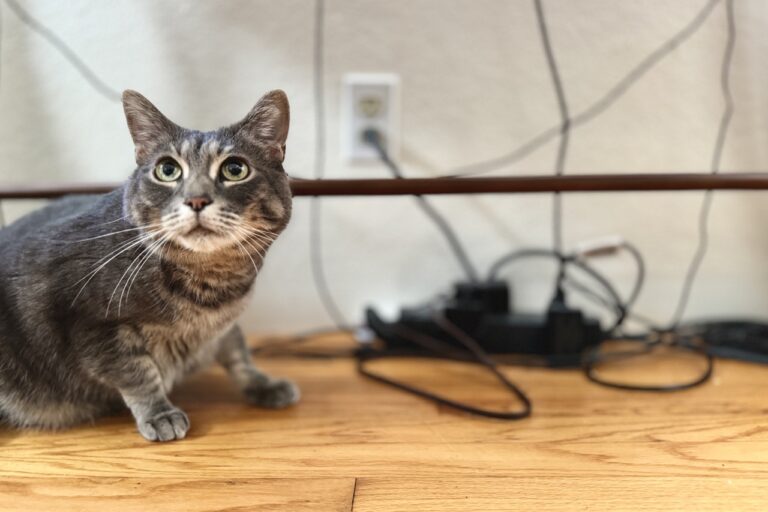How to Cat-Proof Your Electrical Cords (and Why You Should)
Electrical cords can be dangerous to cats. Some leave cords alone, but others like to chew on them.
The biggest risks are electric shocks, burns, or even electrocution if a cat bites through the insulation. Additionally, damaged cords can lead to a fire hazard.
So to be on the safe side, you should cat-proof your electrical cords. Here are three ways to do that:
And as always, cat-proofing anything is incomplete without providing enrichment, play, and training. This is the foundation of behavioral health, a strong bond, and a happy cat.
In the following sections, we’ll explore these effective strategies you can use to deter your cat from chewing on cords and how to secure your electrical devices. It’s worth the peace of mind.

Why Do Cats Chew on Electrical Cords?
Cats, particularly kittens, have a natural instinct to chew as part of their exploratory and play behaviors. A teething kitten will often seek comfort through chewing.
Electrical cords, with their pliable texture, may be prime targets for this behavior. It’s important for cat guardians to recognize that this is a normal developmental stage for kittens.
And some cats don’t outgrow this tendency. Cords that dangle can mimic the movement of small prey.
Boredom, stress, and anxiety can all increase this behavior in cats of all ages. Without sufficient environmental enrichment, cats may turn to chewing cords as an outlet.
Enrichment reduces risks.
The Risks of Not Cat-Proofing Electrical Cords
The risks of your cat chewing on cords are pretty obvious:
- Electric shock and burns causing severe or even fatal injury
- Fire sparked by damaged or short-circuited wires
- Damage to your expensive stuff
So yeah, those are all bad.
3 Cord Cat-Proofing Strategies: Organize, Conceal, Spray
Here are the methods you can use to prevent those bad things from happening, or stop cord chewing if it’s already started.
Organize, Conceal, Spray. These cord strategies can be used in isolation or in any combination.
Organize your cords
For electronics that stay in one place, make sure the cords are tidy. If possible, run them behind or under things so that they’re as hidden and out of reach as possible.
Bundle or tie them with cord organizers. Use adhesive and clips to run them flat along table legs and floor boards.
It might be worth it to pull furniture away from walls for this process so that you can be thorough in taming your cord situation and putting in a solid organizing system.
Conceal your cords
If the above doesn’t work, cord covers and protectors may also be an option. These are bendable tubes or sleeves that can be laid flat against floors or other surfaces, holding cords neatly out of sight.
If you want to get serious in areas with a lot of cords, like around the TV or computer, consider a cable management box. These can go far in cord protection and tidying up a space.
All of these things will serve to make cords look less like tasty toys to your cat. But they will only get you so far, because most people have at least some cords that can’t be handled by tidying and concealing them (e.g., phone chargers).
Spray your cords
For the ones you can’t hide or that your cat won’t seem to leave alone, try using non-toxic bitter spray to apply directly to the cords.
Bitter apple is the most commonly used as a deterrent with cats (and dogs). They also tend to steer clear of citrus.
Affiliate Disclosure: VerveCat is supported by readers. As a member of Amazon Associates and other affiliate programs, we may earn a commission at no added cost to you when you follow a product link and make a purchase.
Listed in the box below are multiple options on Amazon for each of the three cat-proofing methods mentioned. You can also find many of these items at your local hardware store.
The sprays can also be applied directly cord covers. Use a soaked cotton swab for more precise application without spraying all over the place.
Just a little may do the trick, so go light at first and monitor to see if it’s effective. Cats are very sensitive to scents in their environment.
You may have to reapply them periodically because the effect seems to wear off over time.
Some cord protectors are even advertised as “bitter apple infused,” but I think I’d just get the spray separately so that it’s around to spray on other things that might be necessary.
As with any new product, monitor your cat’s reaction to ensure they are put off by the smell/taste and that there are no bad reactions.
Enrichment and Training Are a Must
Enrichment and training are critical complementary pieces of the cat-proofing puzzle. By catifying your home (providing vertical spaces, scratchers, and toys) and playing with your cat every day, you are providing appropriate outlets for natural, instinctual cat behavior.
And training your cat regularly (using positive reinforcement and redirection) to use the cat-stuff and not the forbidden stuff, reinforces the behaviors you want to see and makes those behaviors more likely.
The takeaway here is that enrichment and training will make it less likely that cats do things you don’t want them to do, like chewing on cords. It will also make your cat a happier, healthier cat.
Final Thoughts
Now you’ve got some strategies to put into practice. The options are: organize, conceal, and spray. They can be used alone or in combination. And all cat-proofing is way more effective when it’s done on a foundation of enrichment, training, and play.
For more guidance, check out our comprehensive guide on all the areas of a home to cat-proof and make safer for your cat.

